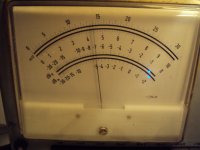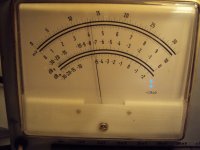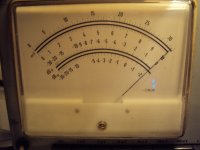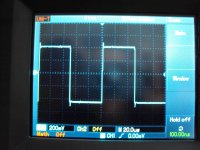The Scope is a UNI-T 2042C.
I think the slight downtilt comes from the 2uF cap i use between the MPP and the Inductive RIAA ( 47kOhm Input Impedance) and the Inductive RIAA has a small lokal rise of 0.5dB at 20Hz. Same result on the DAAS. The serial resistor in series with the inductor could be finetrimmed but i kept it that way because i like the sound very much.
I think the slight downtilt comes from the 2uF cap i use between the MPP and the Inductive RIAA ( 47kOhm Input Impedance) and the Inductive RIAA has a small lokal rise of 0.5dB at 20Hz. Same result on the DAAS. The serial resistor in series with the inductor could be finetrimmed but i kept it that way because i like the sound very much.
Yes, I was remembering so too. If the 2187us, 750us, 318us are met, then slight tilt tailoring can be benign to the correct proportion of overtones to fundamentals. But synergistic overall. Has to do with the majority of MC carts passing supersonic from tip mass on vinyl resonances maybe. Beyond the usual last octave mount. Some speakers do tease easily if excited up there. Not directly, sounds like 3rdH.
P.S. Send me the pics to have a try uploading 4U.
P.S. Send me the pics to have a try uploading 4U.
Have send the pictures.
My Titan has a slight rise in the treble that gets less towards the inner groove.
The third or forth song on an album usually sounds best. Has to do with tonearm geometry ( has minimum error there) and record flattness too that gets better towards the inner when you think about it.
My Titan has a slight rise in the treble that gets less towards the inner groove.
The third or forth song on an album usually sounds best. Has to do with tonearm geometry ( has minimum error there) and record flattness too that gets better towards the inner when you think about it.
In general a slight tilt like 0.1dB to 0.2dB maybe can be evaluated like no big deal on first thought, but when spreading over 10 octaves can have much more of an impact. Who ever tuned a speaker can understand.
Here are Joachim's awesome vintage valve meter's readings for 1kHz and 200kHz left to right. Were just too big that is why they would not upload. I reduced them to 1024x748.
Here are Joachim's awesome vintage valve meter's readings for 1kHz and 200kHz left to right. Were just too big that is why they would not upload. I reduced them to 1024x748.
Attachments
In my professional Lab i use an Instech Precission Bridge with Kelvin leads.
At home i use an ELV 72812 that gives a reading of 9.99nF for a 10nF and 99.9kOhm for a
100kOhm resistor so i can interpolate.
I tested this over a wide range and was very surprised about the repeatability of this inexpensive device.
I also tested voltage acuracy with a chemial voltage reference. For 1.003V it measured
1.004V so that was accurate too.
At home i use an ELV 72812 that gives a reading of 9.99nF for a 10nF and 99.9kOhm for a
100kOhm resistor so i can interpolate.
I tested this over a wide range and was very surprised about the repeatability of this inexpensive device.
I also tested voltage acuracy with a chemial voltage reference. For 1.003V it measured
1.004V so that was accurate too.
Attachments
Errata : I called my friend and he told me that we used a Weston Cell by Hartmann & Braun.
A Weston Cell has 1.018638V and we measured 1.011V on the ELV.
Sorry for this. My brain is too full at the moment.
Weston cell - Wikipedia, the free encyclopedia
A Weston Cell has 1.018638V and we measured 1.011V on the ELV.
Sorry for this. My brain is too full at the moment.
Weston cell - Wikipedia, the free encyclopedia
Today i measured the JG Self with the RIAA Encoder.
A positive surprise. Very quare quarwave and not much overshot this time so the 450kHz resonance in the inductive RIAA seems real. I will try to solve that but i do not think that is is audible.
Here the results for 1kHz and 10kHz into the JG Self.
I bridged the first cap in the subsonic filter to switch out the ICE amendment for this test.
If the Self RIAA is accurate ( i have no doupts) then my Encoder is accurate too.
A very encouraging result. It is posible to build some precisssion stuff at home without much cost if the dedication is there ( plus iron nerves) and the math is correct.
A positive surprise. Very quare quarwave and not much overshot this time so the 450kHz resonance in the inductive RIAA seems real. I will try to solve that but i do not think that is is audible.
Here the results for 1kHz and 10kHz into the JG Self.
I bridged the first cap in the subsonic filter to switch out the ICE amendment for this test.
If the Self RIAA is accurate ( i have no doupts) then my Encoder is accurate too.
A very encouraging result. It is posible to build some precisssion stuff at home without much cost if the dedication is there ( plus iron nerves) and the math is correct.
Attachments
As a little project over the weekend i make a NAB A weighting filter.
There is some space left in the little metal box.
Design is again by Burkhard Vogel.
I made a small change by giving the OP27 stage a bit more gain to get more robust reading on my RMS meter.
Elswhise i listen to music and look some televison to relax.
There is some space left in the little metal box.
Design is again by Burkhard Vogel.
I made a small change by giving the OP27 stage a bit more gain to get more robust reading on my RMS meter.
Elswhise i listen to music and look some televison to relax.
Attachments
My DAAS analyser still packed somewhere in the vaults of the factory i really had the urge to be able to measure distortion at home.
I found a software that is inexpensive at 39,-€ for the professional version and can do what i need. It is called Audiotester. Suport seems to be very good because the designer answered my e-mail on sunday !
I am just trying the shareware version but i am so happy that i will buy the licence.
I tried several soundcards and found that an older Emagic 2/6 48kHz - 24 Bit worked well. I got noise and distortion down to -125dB provided i drive the soundcard in it´s comfotable range. That is 20dB worse than my modified DAAS so i can not make ultra low noise measurements ( i do that at home with my filter bank and the Sennheiser tube meter) but for distortion measurements it´s fine.
The first DUT i measured was the High Z MPP. I had designed and trimmed it theoretically so i was eager to see the results.
Here are measurements at 3 different amplitudes:
I found a software that is inexpensive at 39,-€ for the professional version and can do what i need. It is called Audiotester. Suport seems to be very good because the designer answered my e-mail on sunday !
I am just trying the shareware version but i am so happy that i will buy the licence.
I tried several soundcards and found that an older Emagic 2/6 48kHz - 24 Bit worked well. I got noise and distortion down to -125dB provided i drive the soundcard in it´s comfotable range. That is 20dB worse than my modified DAAS so i can not make ultra low noise measurements ( i do that at home with my filter bank and the Sennheiser tube meter) but for distortion measurements it´s fine.
The first DUT i measured was the High Z MPP. I had designed and trimmed it theoretically so i was eager to see the results.
Here are measurements at 3 different amplitudes:
Attachments
Wow
Hi Joachim,
This is Grrrrrrrrrrrrrrreat!!!
I'll check it tomorrow and will try to download it and start measuring.
Thanks for the tip!
Gr,
Audiofanatic
My DAAS analyser still packed somewhere in the vaults of the factory i really had the urge to be able to measure distortion at home.
I found a software that is inexpensive at 39,-€ for the professional version and can do what i need. It is called Audiotester. Suport seems to be very good because the designer answered my e-mail on sunday !
I am just trying the shareware version but i am so happy that i will buy the licence.
I tried several soundcards and found that an older Emagic 2/6 48kHz - 24 Bit worked well. I got noise and distortion down to -125dB provided i drive the soundcard in it´s comfotable range. That is 20dB worse than my modified DAAS so i can not make ultra low noise measurements ( i do that at home with my filter bank and the Sennheiser tube meter) but for distortion measurements it´s fine.
The first DUT i measured was the High Z MPP. I had designed and trimmed it theoretically so i was eager to see the results.
Here are measurements at 3 different amplitudes:
Hi Joachim,
This is Grrrrrrrrrrrrrrreat!!!
I'll check it tomorrow and will try to download it and start measuring.
Thanks for the tip!
Gr,
Audiofanatic
Here is a comparison of distortion of the left compared to the right channel ( 10 averages) and intermodulation distortion with a taxing combination of 19kHz and 20kHz.
Typical for a non global feedback design is the monotonically falling distortion to lower levels and the monoticity of distortion over frequency.
Noise in the lower reaches seems low and is prove that with good Fets ( 2SK170, 2SJ74)
1/F noise is a smaller problem than many think. For example the precise Burkhard Vogel ruled out Fet´s for MC work but i think in praxis this it not true.
They simply work superbly well.
Typical for a non global feedback design is the monotonically falling distortion to lower levels and the monoticity of distortion over frequency.
Noise in the lower reaches seems low and is prove that with good Fets ( 2SK170, 2SJ74)
1/F noise is a smaller problem than many think. For example the precise Burkhard Vogel ruled out Fet´s for MC work but i think in praxis this it not true.
They simply work superbly well.




